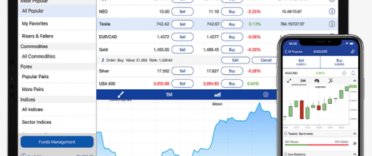 What is a CFD?
What is a CFD?
Contracts for difference (CFDs) are a way of, in effect, betting on what you think is going to happen to the price of a certain asset or part of the market, without actually ever owning the underlying assets. Put simply, you have a contract with a CFD broker whereby you state if you think the price is going to go up or down (you go "long" or "short") and, if you are right, the broker will pay you. If, however, you are wrong, you have to pay the broker.
There is the potential to make money on the price going down, as well as up, which makes it an attractive option during times of market volatility and sets it apart from traditional investment types. CFDs are available for individual shares, indices, commodities, foreign exchange and other asset types.
CFDs are usually leveraged, which means you only have to pay a fraction of the cost of taking out the full position, with the broker "lending" you the remaining amount, but giving you exposure to the full value of the trade. This means there is the potential for supercharged returns, but also magnified losses. It is the risk of the losses being significantly higher than the amount you initially put in that makes CFDs a high-risk investment and one that should only be undertaken by an experienced investor who has a thorough understanding of what this type of investment entails. It is why in the UK the Financial Conduct Authority (FCA) insists that CFD brokers have to display explicit warnings on their sites stating the percentage of their customers that lose money when trading CFDs, which is typically around 70%. It is also why CFDs are banned in a number of countries, including the US and are criticised for being insufficiently regulated in many others.
How does a CFD work?
CFDs mimic the financial markets they are representing, with investors taking out contracts based on whether they think the price will rise or fall, instead of buying shares outright. If the price does what you predicted, you make a profit but if it doesn't, you make a loss. You decide when to close the position, which means selling the contracts you originally bought, either for more than you paid for them (profit) or for less (loss).
For example, you buy 100 CFDs in company ABC for 500p and sell them for 550p. This gives you a profit of £5,000 (100 x 50p). However, if you buy for 500p and sell them for 450p, you make a loss of £5,000 (100 x 50p).
How does leverage work?
CFDs commonly use leverage, with investors only having to pay a deposit - known as a "margin" - to participate in the full trade. This means you only have to put up a fraction of the cost, but your profits or losses are amplified. The broker will tell you what margin is required to participate in a trade.
For instance, following on from the example above, you think the price of company ABC is going to go up. A share in ABC is 500p, so if you want to buy it without leverage, it will cost £5,000 for 100 shares. If, however, you pay a margin of 20% for the trade, you can get exposure to £5,000 worth of shares but only pay £1,000. That means that when the price of the share goes up to 550p, you still make £500 profit (100 x 50p), but on an initial investment of just £1,000.
On the flipside, if you pay the margin of 20% of the trade and get exposure to £5,000 worth of shares for £1,000, but the share price drops to 450p, you make a loss of £500. If you had bought the shares directly at face value instead of using leverage via a CFD you would have only lost £100. That's because your £1,000 would have bought 200 shares at 500p which are now worth 450p each, meaning a total of 450p x 200 = £900. However, by using leverage, you would have lost £500, which is five times the loss when investing directly in the shares.
The examples above don't include fees, which could include commission, spread and overnight financing charges.
Advantages of trading CFDs
- You can access a wide range of markets without having to buy the underlying assets
- You can greatly increase your profits if you use leverage
- You can take long or short positions, which means you can get returns during a falling market
- Leverage means less of your capital is tied up in the trade, meaning you can put it to work somewhere else
Disadvantages of trading CFDs
- The potential for making a loss is considerable, especially if you don't know what you are doing
- They are relatively complicated instruments, which only makes them suitable for experienced investors
- They can attract additional charges, which may not always be obvious at the outset
CFDs vs Share trading
When it comes to investing in shares directly (i.e. share trading rather than using a CFD), you can either buy and hold them in the hope that the value of the shares goes up over time, or you can trade them, capitalising on short-term price movements. With share trading you are trying to time the market, buying and selling at the right time to maximise your profit. As with investing in CFDs, correctly guessing what is going to happen to the share price isn't easy, with the market often shifting unpredictably.
The key difference between using CFDs and share trading is the fact that, with share trading, you actually own the underlying asset. This means you can enjoy the benefits of being a shareholder, including receiving dividends with some shares. Additionally, with share trading, unlike CFDs, you can't opt to short a position if you think the share price is going to fall. It also means that, unlike CFDs with leverage, with share trading you can't lose more than the initial amount you invested. The greatest risk is that the company whose shares you own goes bust and you lose all the money you have put in.
Key features of CFDs vs Share trading
| CFDs | Share trading |
| Have a contract based on the price of a particular asset | Own the share or ETF outright |
| Can take long or short positions, benefitting if the price goes up or down, respectively | Can only take a long position, making a gain only if the share price rises |
| Use leverage so you only have to pay a margin but get exposure to the full value of the position | Have to invest the full value of the share (although some brokers such as Freetrade, Trading 212 and eToro do offer the ability to buy fractional shares) |
| Can get much higher profits or losses by using leverage | Only stand to lose the money you put in, but are also limited on the profit you can make when compared with CFDs |
| Can trade in shares, indices, commodities, foreign exchange and other asset types | Limited to trading in shares and ETFs |
Summary: Is trading CFDs a good idea?
While CFDs are growing in popularity as more and more people try their hand at trading, they present as many risks as they do potential rewards. Speculating on price movement, even for seasoned professionals, is difficult and your chance of losing money if you get it wrong is high. Add in the effects of leverage and you stand to lose many times your original investment. You only have to look at the risk warning that is displayed in the top banner of your chosen trading app or website to understand the risk that trading CFDs represents. Most will quote a figure of around 70%-85% of retail investors lose money when trading CFDs.
Overall, CFDs are only suitable for those who fully understand this complex area of the market, can manage their losses and not fall into the trap of running up huge debts.




